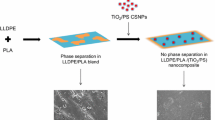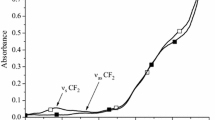Abstract
In this research work, the effect of the change in the surface area of silicon dioxide nanoparticles of the same size on mechanical properties of poly(lactic acid) nanocomposites (PLA) was studied, as well as the role of coupling agent amount in the compatibility of these nanomaterials. We consider a spherical silicon dioxide with a surface area of 170–200 m2/g (labeled as S–SiO2) and another considered amorphous with a surface area of 180–600 m2/g (labeled as P-SiO2). This surface areas difference plays an important role in modifying of nanoparticles polarity by incorporating a coupling agent and its integration into partially polar polymers. According to obtained results, for nanomaterials with high surface area, it was observed while increasing coupling agent amount, the elasticity of the composite was observed to increase. In contrast, in nanomaterials with spherical nanoparticles, it was observed that as the amount of coupling agent decreases, the resistance of the material increases, reaching a maximum when a 10:2 ratio is used. It was observed that behaviors for both nanoparticles were different, which gives an idea that the incorporation of nanoparticles in polymers is not an issue of coupling agent or quantity only, it is more important as it is arranged on the surface. This kind of couplings does not only affect mechanical properties, since the thermal behavior of the material was also influenced, where it was observed that particles with low surface area modify the crystallization rate when they have different percentages of coupling agent on the surface. Furthermore, it is observed that the incorporation of nanoparticles with high surface areas area does not modify the crystallization rate significantly. Besides, in both cases, it was observed that the highest crystallization rate is reached when a 10:2 ratio is used. However, the energy required to form crystals remains unchanged. Therefore, it is considered that the incorporation of nanoparticles only affects the crystal formation rate without disturbing the energy requirement for crystal formation. Finally, a maximum in the 10:2 ratio was observed for the compatibility in both particles, which was manifested in an increase in the storage module through a dynamic mechanical analysis. The rate of crystal formation as well as the number of formed crystals have a considerable effect on mechanical properties of nanocomposites when the surface area is modified.








Similar content being viewed by others
References
Nabi Saheb D, Jog JP (1999) Natural fiber polymer composites: a review. Adv Polymer Technol J Polymer Process Inst 18(4):351–363
Lim L-T, Auras R, Rubino M (2008) Processing technologies for poly (lactic acid). Progress Polymer Sci 33(8):820–852
Sengupta S, Manna S, Roy U, Das P (2018) Manufacturing of biodegradable poly lactic acid (pla): green alternatives to petroleum derived plastics. In: Reference module in materials science and materials engineering. Encyclopedia of renewable and sustainable materials, vol 3. Elsevier, pp 561–569
Wang G, Zhang D, Wan G, Li Bo, Zhao G (2019) Glass fiber reinforced pla composite with enhanced mechanical properties, thermal behavior, and foaming ability. Polymer 181:121803
Suryanegara L (2009) Antonio Norio Nakagaito, and Hiroyuki Yano 2009 The effect of crystallization of pla on the thermal and mechanical properties of microfibrillated cellulose-reinforced pla composites. Compos Sci Technol 69:1187–1192
Chen P-Y, Lian H-Y, Shih Y-F, Chen-Wei S-M, Jeng R-J (2017) Preparation, characterization and crystallization kinetics of kenaf fiber/multi-walled carbon nanotube/polylactic acid (pla) green composites. Mater Chem Phys 196:249–255
Hung C-Y, Wang C-C, Chen C-Y (2013) Enhanced the thermal stability and crys- tallinity of polylactic acid (pla) by incorporated reactive ps-b-pmma-b-pgma and ps-b-pgma block copolymers as chain extenders. Polymer 54(7):1860–1866
Garcia CV, Shin GH, Kim JT (2018) Metal oxide-based nanocomposites in food packaging: applications migration and regulations. Trends Food Sci Technol 82:21–31
Shankar S, Wang L-F, Rhim J-W (2018) Incorporation of zinc oxide nanoparticles improved the mechanical, water vapor barrier, uv-light barrier, and antibacterial properties of pla- based nanocomposite films. Mater Sci Eng, C 93:289–298
Sarikhani K, Nasseri R, Lotocki V, Thompson RB, Park CB, Chen P (2016) Effect of well-dispersed surface-modified silica nanoparticles on crystallization behavior of poly (lactic acid) under com- pressed carbon dioxide. Polymer 98:100–109
Vandenberg ET, Bertilsson L, Liedberg B, Uvdal K, Erlandsson R, Elwing H, Lundström I (1991) Structure of 3-aminopropyl triethoxy silane on silicon oxide. J Colloid Interface Sci 147(1):103–118
Vallejo-Montesinos J, Gámez-Cordero J, Zarraga R, Pérez MCP, Gonzalez-Calderon JA (2020) Influence of the surface modification of titanium dioxide nanoparticles TiO2 under efficiency of silver nanodots deposition and its effect under the properties of starch–chitosan (sc) films. Polymer Bull 77(1):107–133
López-Zamora L, Martínez-Martínez HN, González-Calderón JA (2018) Improvement of the colloidal stability of titanium dioxide particles in water through silicon based coupling agent. Mater Chem Phys 217:285–290
Gonzalez-Calderon JA, Mendoza G, Peña-Juárez MG, Pérez E et al (2020) Use of chemically modified titanium dioxide particles to mediate the non-isothermal cold crystallization of poly (latic acid). J Mexican Chem Soc 64(2):117–136
Knowles GP, Graham JV, Delaney SW, Chaffee AL (2005) Aminopropyl- functionalized mesoporous silicas as co2 adsorbents. Fuel Process Technol 86:1435–1448
Jaksa G, Štefane B, Kovač J (2014) Influence of different solvents on the morphology of aptms-modified silicon surfaces. Appl Surf Sci 315:516–522
Jakša G, Štefane B, Kovač J (2013) Xps and afm characterization of aminosilanes with different numbers of bonding sites on a silicon wafer. Surf Interface Anal 45(11–12):1709–1713
Saeidlou S, Huneault MA, Li H, Park CB (2012) Poly (lactic acid) crystallization. Progress Polymer Sci 37(12):1657–1677
Rene Androsch HM, Iqbal N, Schick C (2015) Non-isothermal crystal nucleation of poly (l-lactic acid). Polymer 81:151–158
As’habi L, Jafari SH, Khonakdar HA, Häussler L, Wagenknecht U, Heinrich G (2013) Non-isothermal crystallization behavior of pla/lldpe/nanoclay hybrid: synergistic role of lldpe and clay. Thermochim Acta 565:102–113
Chen H, Pyda M, Cebe P (2009) Non-isothermal crystallization of pet/pla blends. Ther- mochimica Acta 492(1–2):61–66
Li H, Huneault MA (2007) Effect of nucleation and plasticization on the crystallization of poly (lactic acid). Polymer 48(23):6855–6866
Nofar M, Tabatabaei A, Park CB (2013) Effects of nano-/micro-sized additives on the crystallization behaviors of pla and pla/co2 mixtures. Polymer 54(9):2382–2391
Tsuji H, Takai H, Fukuda N, Takikawa H (2006) Non-isothermal crystallization behavior of poly (l-lactic acid) in the presence of various additives. Macromol Mater Eng 291(4):325–335
Lizundia E, Penayo MC, Guinault A, Vilas JL, Domenek S (2019) Impact of zno nanoparticle morphology on relaxation and transport properties of pla nanocomposites. Polym Testing 75:175–184
Kissinger HE (1956) Variation of peak temperature with heating rote in differential thermal analysis. J Res NatlBureau Standards 57:217
Blaine RL, Kissinger HE (2012) Homer kissinger and the kissinger equation. Thermochim Acta 540:1–6
Vyazovkin S (2002) Is the kissinger equation applicable to the processes that occur on cooling? Macro- molecular Rapid Commun 23(13):771–775
Vyazovkin S, Burnham AK, Criado JM, Perez-maqueda LA, Popescu C, Sbirrazzuoli N (2011) ICTAC Kinetics Committee recommendations for performing kinetic computations on thermal analysis data. Thermochim Acta 520:1–19
Friedman HL (1969) New methods for evaluating kinetic parameters from thermal analysis data. J Polymer Sci Part B Polymer Lett 7(1):41–46
Liao DL, Wu GS, Liao BQ (2009) Zeta potential of shape-controlled tio2 nanoparticles with surfactants. Colloids Surf, A 348(1–3):270–275
Alvarado ED, Juárez MGP, Pérez CP, Perez E, Gonzalez JA et al (2019) Improvement in the dispersion of tio2 particles inside chitosan-methyl cellulose films by the use of silane coupling agent. J Mexican Chem Soc 63(2):154–168
Papageorgiou GZ, Achilias DS, Nanaki S, Beslikas T, Bikiaris D (2010) PLA nanocomposites: effect of filler type on non-isothermal crystallization. Thermochim Acta 511(1–2):129–139
Fernández MJ, Fernández MD (2020) Effect of organic modifier and clay content on non-isothermal cold crystallization and melting behavior of polylactide/organovermiculite nanocomposites. Polymers 12(2):364
Chen Y, Yao X, Qun Gu, Pan Z (2013) Non-isothermal crystallization kinetics of poly (lactic acid)/graphene nanocomposites. J Polym Eng 33(2):163–171
Zhang Y, Deng B, Liu Q, Chang G (2013) Nonisothermal crystallization kinetics of poly (lactic acid)/nanosilica composites. J Macromol Sci, Part B 52(2):334–343
Zhu A, Diao H, Rong Q, Cai A (2010) Preparation and properties of polylactide—silica nanocomposites. J Appl Polym Sci 116(5):2866–2873
Pilla S, Kramschuster A, Yang L, Lee J, Gong S, Turng L-S (2009) Microcellular injection-molding of polylactide with chain-extender. Mater Sci Eng, C 29(4):1258–1265
Mofokeng JP, Luyt AS, Tábi T, Kovács J (2012) Comparison of injection moulded natural fibre-reinforced composites with pp and pla as matrices. J Thermop Compos Mater 25(8):927–948
Wen X, Lin Y, Han C, Zhang K, Ran X, Li Y, Dong L (2009) Thermomechanical and optical properties of biodegradable poly (l-lactide)/silica nanocomposites by melt compounding. J Appl Polym Sci 114(6):3379–3388
Glotzer SC, Paul W (2002) Molecular and mesoscale simulation methods for polymer materials. Ann Rev Mater Res 32(1):401–436
Huang TC, Yeh JM, Yang JC (2010) Effect of silica size on the thermal, mechanical and biodegradable properties of polylactide/silica composite material prepared by melt blending. Adv Mater Res 123-125:1215–1218
Pothan LA, Oommen Z, Thomas S (2003) Dynamic mechanical analysis of banana fiber reinforced polyester composites. Compos Sci Technol 63(2):283–293
Zhao Y, Qiu Z, Yang W (2009) Effect of multi-walled carbon nanotubes on the crystallization and hydrolytic degradation of biodegradable poly (l-lactide). Compos Sci Technol 69(5):627–632
Jyh-Hong Wu, Yen MS, Kuo MC, Chen BH (2013) Physical properties and crystallization behavior of silica particulates reinforced poly (lactic acid) composites. Mater Chem Phys 142(2–3):726–733
Acknowledgements
The authors wish to thank Consejo Nacional de Ciencia y Tecnología (CONACYT) for the scholarship granted to Isidro Montes-Zavala that allowed the fulfillment of this work. E. O. Castrejón-González wishes to acknowledge CONACYT for financial support through Project No. INFR-2015-01-254675. The authors want to acknowledge to Fernando Rodríguez Juárez for the facilities given in SEM tests. The authors express their gratitude to CONACYT for the support to J.A. González-Calderón through the “Cátedras CONACYT” program.
Author information
Authors and Affiliations
Corresponding author
Additional information
Publisher's Note
Springer Nature remains neutral with regard to jurisdictional claims in published maps and institutional affiliations.
Rights and permissions
About this article
Cite this article
Montes-Zavala, I., Pérez-González, M.J., Castrejón-González, E.O. et al. Thermal and mechanical properties of poly(lactic acid) filled with modified silicon dioxide: importance of the surface area. Polym. Bull. 79, 1409–1435 (2022). https://doi.org/10.1007/s00289-021-03571-7
Received:
Revised:
Accepted:
Published:
Issue Date:
DOI: https://doi.org/10.1007/s00289-021-03571-7




